Tiger Tank I
This German Tiger Tank I Ausf. E Heavy Tank panzerkampfwagen VI was for many years displayed at the Deutsches Panzermuseum in Munster, Germany. Its owner has now reclaimed it saying he wants to try and make it a run under its own power. It was removed from public display in November 2017.
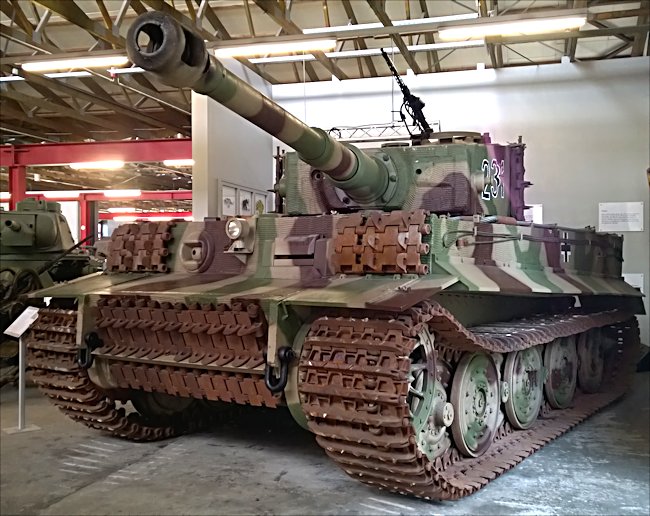
German WW2 Tiger Tank Panzerkampfwagen VI
Why is this Tiger Tank nicknamed 'Frankentiger' ?
This Tiger Tank has been restored using many parts from different Tiger Tanks wrecks found at a number of junkyards around Europe and welded to an empty hull with 10% fresh new steel? Just like Frankenstein's monster it is made up of parts from different bodies. The wheels and gun barrel came from the Kurland area in Latvia. The tracks are full reproductions. It was constructed by Monsieur Hoebig. He was once the owner of the Trun scrapyard in Normandy. It does not have an engine or gear box.
It's official German Army designation was Panzerkampfwagen VI Tiger Ausf. E or just the Tiger Tank. The suffix number one was added when the King Tiger tank was produced. It becoming the Tiger II and the original Tiger tank was renamed the Tiger I.
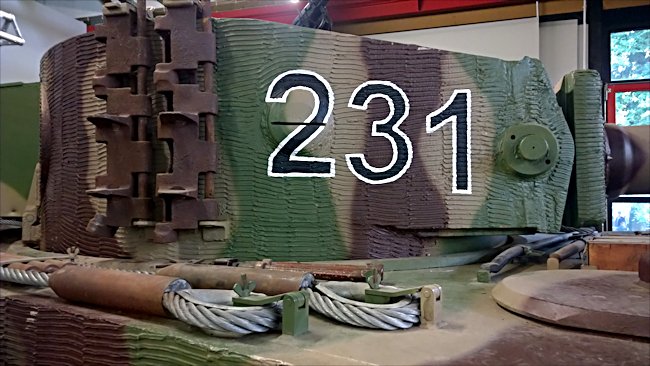
Anti-magnetic mine paint called Zimmerit has been added to the sides of Tiger Tank 231
Tiger Tanks defend the Rhineland
On the 8th February 1945 the Allies had entered Germany and were heading towards the German town of Xanten that was on the Rhine River. They wanted to capture a bridge intact. They were looking for a way to enter the heartland of Germany and then on to berlin.
The Germans were short of tanks, fuel, supplies, ammunition and infantry. The Allies believed that they would just give up. The opposite happened. The Germans were now even more fanatical and stubborn in defence because they were now fighting for the defence of their fatherland. They only had a few Tiger and Panther tanks compared with the hundreds of Sherman tanks the Allies had. These limited resources had to be used wisely where they could do the most damage.
On the 27th February Operation Blockbuster started. The spring melt of snow and ice had come early which cause the ground to become saturated in water. It was supposed to be a night attack but the flooded fields and muddy conditions caused delays. Trooper Jack Gardiner, Sherman Tank Crew in the South Alberta Regiment had been ordered with the rest of his regiment to attack the German held area around the town of Udem and seize the railroad embankment. It was on an area of high ground.
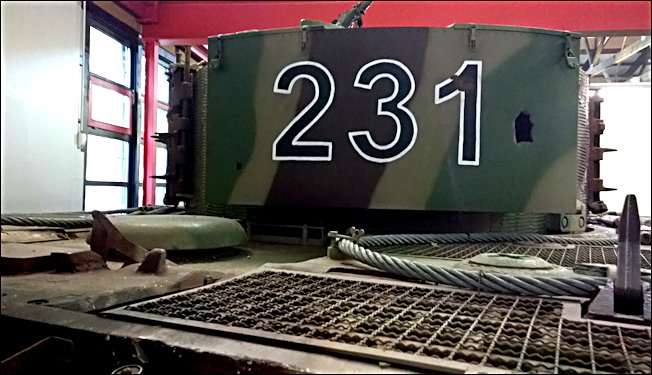
When this Tiger Tank was put together original battle damage was left as found and not repaired. You can see the back turret box was hit three times.
He remembers, "When the time came we moved out. I can still remember driving along, or I should say, slithering along. It took hours to go one mile. It was just unbelievable and very frustrating. We were supposed to start at 11.30 at night. We did not get to the start line until 2 o’clock in the morning because of the thick mud."
"Intelligence had said the town of Udem was pretty vacant. But you never take that for granted. Anything that moved was shot up. Even though it was high ground the terrain was terrible. It took us ages to get to our objective. There were tank traps, great big dug out holes. If you fell into one you were finished. You could not get out."
"The way those tank ditches were designed was to push us onto one of the roads that went on top of the dikes. It was a piece of high ground out of the mud. The going was easier so naturally we took it, not thinking it was a trap. Either side were great big deep ditches. Once you get on it you cannot get off it. We just fell right into line and into the German’s carefully worked out ambush."
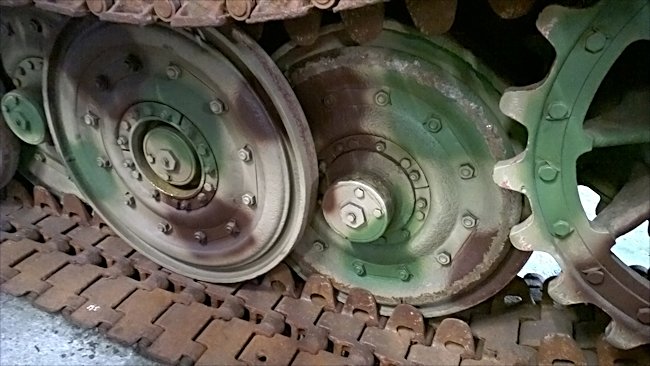
It was not an easy job changing a damaged track wheel on a Tiger Tank
"It was the worst thing that could happen to an armoured column, have your tanks one behind the other. They were just waiting for us. The German Tiger tanks had been dug in so all you could see was their turret off tour side. There were a number of 88mm anti-tank guns dug in amongst them too. We were just sitting ducks."
"Eddie, he was at the front and saw a tiger I tank. I guess he knew the Tiger was drawing a bead on him. Eddie loaded up an AP, an armour piercing shell. He got that out but the God dam shell just bounced off the tiger’s hide. So he knew he had to go to stage two. Look for and get that opening. With his next round he did it. He managed to jam the turret of the Tiger by hitting it in the gap between the hull and the turret."
"It all just happened very fast after that. They hit the front tank and then the rear tank. They then took out every other tank in the middle. We were hit in the soft spot in the back. It was very abrupt, deafening, instant. You then jumped into action. You had to get out fast. That baby is burning. We were fortunate. We all managed to get out and made a run for it towards a farmhouse. There we were captured and spent the remaining months of the war as a prisoner."
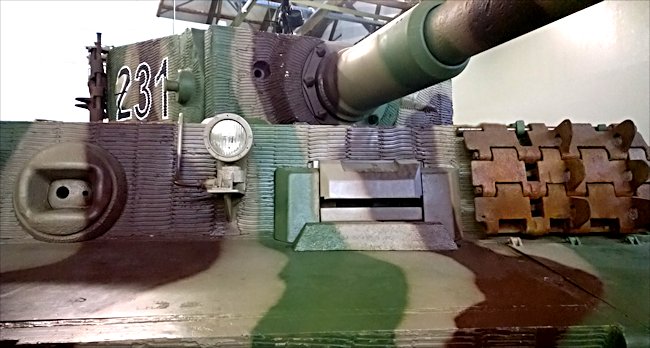
Most Allied tanks could not penetrate the front 100mm thick armour of a Tiger Tank
"When you were there you did not know why they were fighting so hard. You did not have time to understand that they were fighting for their homes. We knew they were beat. We thought that they must know they were beaten. We could not understand it. They were fighting and not surrendering. We became very resentful at the unnecessary loss of life. All the German soldiers believed that each day they could hold their position they were helping their country by stopping their enemies getting to the industrial heart of the Reich."
The Tiger tanks meet the enemy they cannot fight
Whilst Trooper Jack Gardiner, Sherman Tanks of South Alberta Regiment were busy on the Udem ridge more of his regiment had been sent into the heavily defended Hochwald gap the cuts the heavily forested Hochwald Ridge in two. The first attempt meet with a hail of fire from concealed 88mm anti-tank guns, StuG III, Jagdpanther IV, panther and tiger tanks. Many Shermans were left burning on the valley floor yet they still pushed on into the pass.
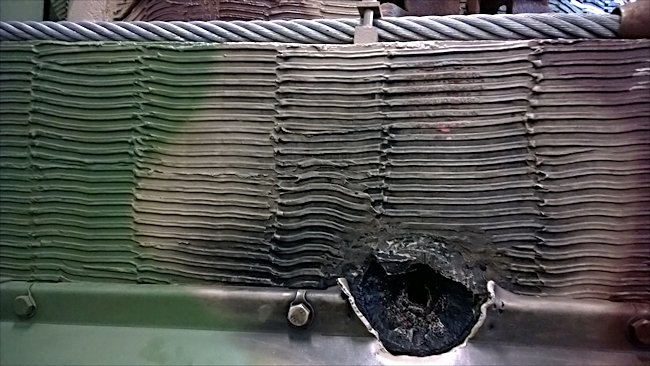
This photo shows where an allied shell has managed to penetrate the side armour of this Tiger Tank
heading our way at close range. Our gunners had them in their sights, including our 17pdr Sherman Firefly. Before their tanks levelled out on flat ground to bring their 88mm and 75mm guns down on to us, we fired at their exposed hull and track. We stopped their advance. The Panther tank was destroyed. Our shells bounced off the tiger but he was not willing to take the risk of being out flanked as he was out numbered, so he retreated."
The battle went on and on. Both sides losing tanks, troops and anti-tank guns. The German Tigers were still all intact and proving nearly impossible to knock out. The situation seemed desperate for the Canadians. Then it all changed. The bad weather cleared. Help appeared over head from the sky. RAF rocket firing Typhoon ground attack bombers came to the rescue.
The tank crews affectionately called them ‘tiffys’. They would fire at the Tigers with their cannons. The tracer would show them when they were on target. The pilot would then immediately launch a salvo of rockets. A direct hit would break a tiger or Panther tank into pieces. The remaining German troops and tanks that escaped the rocket attacks withdraw to the River Rhine town of Xanten.
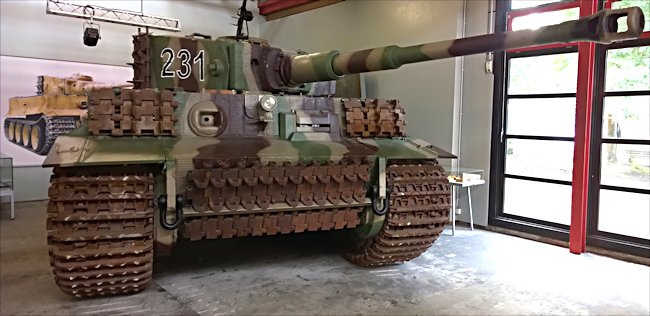
The 'Frankentiger' Tiger Tank at the German Tank Museum in Munster.
Tiger tank ace Michael Wittmann's final battle
The Allies had broken out of the D-day bridgehead and finally taken Caen. They were now heading south towards Falaise as part of Operation Totalize, which started with the first ever armoured night attack on 7th August 1944. Hitler’s Army was heading toward being surrounded and destroyed as the Americans were closing in from the south and east. This action would later be known as the battle for the Falaise Gap.
The 12th SS Panzer Division were ordered to bar the advance of the British, Canadian and Polish forced heading down the Caen – Falaise highway. Tank Ace German Captain Michael Wittmann commanded the few remaining Panzer VI Tiger I tanks in that Division. Waffen SS-Colonel Kurt Meyer who was overall command of the 12th SS Panzer Division recorded, "Wittmann’s Tigers were behind a hedge east of the village of Cintheaux. We had to risk the attack in order to win time."
Wittmann was in reserve but he volunteered to lead the attack. Operations Officer Hans Hoflinger recorded, "Michael said to me as the other officers can barely cope. SS-Colonel Kurt Meyer knew the situation was hopeless. They were incredibly outnumbered and did not have air supremacy. "I shook Michael’s hand as he left with his youthful laugh as he climbed into his Tiger."
Michael Wittmann’s Tigers set off on this counter attack. Just eight German Tiger Tanks advancing against over 300 allied tanks. What he did not know was that there was a hidden danger waiting for him, an ambush, a trap. By the side of the Caen-Falaise rod just north of Cintheaux British tanks of the Northamptonshire Yeomanry were lying in wait in the woods to his right. Canadian tanks of the Sherbrooke Fusiliers were waiting behind an old stone wall that surrounded the estate of a French Chateaux to his left.
Hans Hoflinger recorded, "We drove off, Michael right of the road and I was on the left. Approximately 800m to Michaels’s right there was a small wood which looked suspicious."
British Sherman tanks hidden in the woods observed Wittmann’s column of Tiger Tanks advancing in front of them, exposing their weaker side armour. The road was slightly raised above the level of the surrounding fields. Four Tigers were on the side nearest to the British. The Canadian Tanks hiding behind the tall estate boundary wall were much nearer to the road.
Canadian Tank Crew S.V.Radley-Walters of the Sherbrooke Fusiliers recalled, "We sneaked up right beside a brick wall and got in reasonable cover. We hit the wall just enough so that you could move the gun sufficiently. The fallen rubble protected our hull. I could see on my right the first German tanks that came out from Cintheaux. Right away I can remember the wireless net becoming active. ‘I can see them. I can see them.’"
British Tanker Joe Ekins, in his tank in the woods recalled, "I saw three Tigers coming across in front of us, about 1200 yards away. My tank commander said, ‘We’ll wait until they get to about 800 yards.’ I was now starting to get a bit itchy."
The British and Canadian tank units had a new weapon. The Sherman Firefly tank that was fitted with an upgraded 17pdr anti-tank gun. For every standard Sherman tanks there was one Sherman Firefly. The 17 pounder gun could penetrate 130mm of armour plate. It was a Tiger Tank killer. Wittmann’s tanks were now in the kill zone.
Partly hidden by the knocked down wall, S.V.Radley-Walters of the Sherbrooke Fusiliers recalled, "With my eyes I could see the tank closest to the road, 200 yards I guess."
Gunner Joe Ekins then heard his tank commander say "Advance driver. As we are pulling out of cover he says, ‘Target the rear Tiger.’ I fired. I looked around at the second tank. I fired one shot at it. The loader reloads and I fired when he was ready. Three of the four Tiger tanks on our side of the road were knocked out hit in the side or rear.
Wittmann’s Tiger tank moved on alone. Hans Hoflinger recorded, "We began taking heavy fire. Then I received a radio message from Michael, ‘Attention, Attention, attack from the right,’ having just spotted the danger." The Canadians now started to fire on Wittmann’s tank. His tank with the turret identity number 007 was hit. Hans Hoflinger continued "When I got to within 300m of Michaels tank flames suddenly shot from the tank
Canadian Tank Crew S.V.Radley-Walters of the Sherbrooke Fusiliers had been firing on Michael Wittmanns tank along with tanks from the rest of his unit by the Chateaux wall. "I can remember a tremendous explosion and seeing the turret hit the ground."
On the 8th August 1944 German tank ace Captain Michael Wittmann fought his final battle. He and his tank crew died instantly when the Tiger tank’s ammunition exploded. He is buried in a German Military cemetery in Caen.
WW2 tank books

